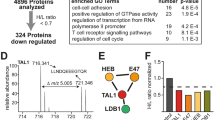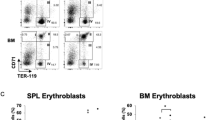Abstract
MicroRNAs (miRNAs) are small non-coding RNAs of 19–25 nucleotides that are involved in the regulation of critical cell processes such as apoptosis, cell proliferation and differentiation. However, little is known about the role of miRNAs in granulopoiesis. Here, we report the expression of miRNAs in acute promyelocytic leukemia patients and cell lines during all-trans-retinoic acid (ATRA) treatment by using a miRNA microarrays platform and quantitative real time–polymerase chain reaction (qRT–PCR). We found upregulation of miR-15a, miR-15b, miR-16-1, let-7a-3, let-7c, let-7d, miR-223, miR-342 and miR-107, whereas miR-181b was downregulated. Among the upregulated miRNAs, miR-107 is predicted to target NFI-A, a gene that has been involved in a regulatory loop involving miR-223 and C/EBPa during granulocytic differentiation. Indeed, we have confirmed that miR-107 targets NF1-A. To get insights about ATRA regulation of miRNAs, we searched for ATRA-modulated transcription factors binding sites in the upstream genomic region of the let-7a-3/let-7b cluster and identified several putative nuclear factor-kappa B (NF-κB) consensus elements. The use of reporter gene assays, chromatin immunoprecipitation and site-directed mutagenesis revealed that one proximal NF-κB binding site is essential for the transactivation of the let-7a-3/let-7b cluster. Finally, we show that ATRA downregulation of RAS and Bcl2 correlate with the activation of known miRNA regulators of those proteins, let-7a and miR-15a/miR-16-1, respectively.
This is a preview of subscription content, access via your institution
Access options
Subscribe to this journal
Receive 50 print issues and online access
$259.00 per year
only $5.18 per issue
Buy this article
- Purchase on Springer Link
- Instant access to full article PDF
Prices may be subject to local taxes which are calculated during checkout







Similar content being viewed by others
Change history
11 May 2022
A Correction to this paper has been published: https://doi.org/10.1038/s41388-022-02351-5
References
Bartel DP . (2004). MicroRNAs: genomics, biogenesis, mechanism, and function. Cell 116: 281–297.
Bowen DT, Frew ME, Hills R, Gale RE, Weathley K, Groves M et al. (2005). RAS mutation in acute myeloid leukemia is associated with distinct cytogenetic subgroups but does not influence outcome in patients younger than 60 years. Blood 106: 2113–2119.
Bruel A, Benoit G, De Nay D, Brown S, Lanotte M . (1995). Distinct apoptotic responses in maturation sensitive and resistant t (15; 17) acute promyelocytic leukemia NB4 cells. 9cis retinoic acid induces apoptosis independent of maturation and Bcl-2 expression. Leukemia 9: 1173–1184.
Chan IT, Kutok JL, Williams IR, Cohen S, Moore S, Shigematsu H et al. (2006). Oncogenic K-ras cooperates with PML-RAR alpha to induce an acute promyelocytic leukemia-like disease. Blood 108: 1708–1715.
Chen CZ, Li L, Lodish HF, Bartel DP . (2004). MicroRNAs modulate hematopoietic lineage differentiation. Science 303: 83–86.
Cheng AM, Byrom MW, Shelton J, Ford LP . (2005). Antisense inhibition of human miRNAs and indications for an involvement of miRNA in cell growth and apoptosis. Nucleic Acids Res 33: 1290–1297.
Cimmino A, Calin GA, Muller F, Iorio M, Ferracin M, Shimitzu M et al. (2005). Mir-15a and miR-16-1 induced apoptosis by targeting BCL2. Proc Natl Acad Sci USA 102: 13944–13949.
Dechend R, Hirano F, Lehmann K, Heissmayer V, Ansieau S, Wulczyn F et al. (1999). The Bcl-3 oncoprotein acts as a bridging factor between NF-κB/Rel and nuclear co-regulators. Oncogene 18: 3316–3323.
Dresios J, Aschrafi A, Owens GC, Vanderkilsh PW, Edelman GM, Mauro VP . (2005). Cold stress induced protein Rbm3 binds 60S ribosomal subunits, alters microRNA levels, and enhances global protein synthesis. Proc Natl Acad Sci USA 102: 1865–1870.
Fazi F, Rosa A, Fatica A, Gelmetti V, Marchis ML, Nervi C et al. (2005). A mini-circuitry comprising microRNA-223 and transcription factors NFI-A and C/EBPa regulates human granulopoiesis. Cell 123: 819–831.
John B, Enright J, Aravin A, Tuschl T, Sander C, Marks DS . (2004). Human microRNA targets. Plos biology 11: e363.
Johnson SM, Grosshands H, Shingara J, Byrom M, Jarvis R, Cheng A et al. (2005). Ras is regulated by the let-7 microRNA family. Cell 120: 635–647.
Kel AE, Gossling E, Reuter I, Cheremushkin E, Kel-Margoulis OV, Wingender E . (2003). MATCH: a tool for searching transcription factor binding sites in DNA sequences. Nucleic Acids Res 31: 3576–3579.
Kolch W . (2005). Coordinating ERK/MAPK signalling through scaffolds and inhibitors. Nat Rev Mol Cell Biol 11: 827–837.
Kurland JF, Kodym R, Story MD, Spurgers KB, Mc Donnell TJ, Meyn RE . (2001). NF-kappaB1 (p50) homodimers contribute to transcription of the bcl-2 oncogene. J Biochem Chem 30: 45380–45386.
Krek A, Grün D, Poy M, Wolf R, Rosenberg L, Epstein EJ et al. (2005). Combinatorial microRNA target predictions. Nat Genet 37: 495–500.
Lewis BP, Shih IH, Jones-Rhoades MW, Bartel P, Burge CB . (2003). Prediction of mammalian microRNA targets. Cell 115: 787–798.
Liu CG, Calin GA, Meloon B, Gamliel N, Sevignani C, Ferracin M et al. (2004). An oligonucleotide microchip for genome-wide microRNA profiling in human and mouse tissues. Proc Natl Acad Sci USA 101: 9740–9744.
Mathieu J, Giraudier S, Lanotte M, Besancon F . (2005). Retinoic-induced activation of NF-kB in APL cells is not essential for granulocytic differentiation, but prolongs the life span of mature cells. Oncogene 24: 7145–7155.
Meani N, Minardi S, Licciulli S, Gelmetti V, Lo Coco F, Nervi C et al. (2005). Molecular signature of retinoic acid treatment in acute promyelocytic leukemia. Oncogene 24: 3358–3368.
Melnick A, Licht JD . (1999). Deconstructing a disease: RARalpha, its fusion partners, and their roles in the pathogenesis of acute promyelocytic leukemia. Blood 93: 3167–3215.
Mori N, Fujii M, Ikeda S, Yamada Y, Tomonaga M, Ballard DW et al. (1999). Constitutive activation of NF-κB in primary adult T-cell leukemia cells. Blood 93: 2360–2368.
Poy MN, Eliasson L, Krutzfeldt J, Kuwajima S, Ma X, McDonald PE et al. (2004). A pancreatic islet-specific microRNA regulates insulin secretion. Nature 432: 226–230.
Priel IP, Cai DH, Wang D, Kowalski J, Blackford A, Liu H . (2005). CCAAT/Enhancer binding protein α(EBPα) and C/EBPα myeloid oncoproteins induce Bcl-2 via interaction of their basic regions with nuclear factor-κB p50. Mol Cancer Reser 3: 585–596.
Tusher VG, Tibshirani R, Chu G . (2001). Significance analysis of microarrays applied to the ionizing radiation response. Proc Natl Acad Sci USA 98: 5116–5121.
Udalova IA, Richardson A, Denys A, Smith C, Ackerman H, Foxwell B et al. (2000). Functional consequences of a polymorphism affecting NF-κB p50-p50 binding to the TNF promoter region. Mol Cell Biol 20: 9113–9119.
Acknowledgements
This work was supported by National Cancer Institute/National Institutes of Health Grants, P01CA76259, P01CA16058 and P01CA81534 (CMC), P01 CA055164 and the Paul and Mary Haas Chair in Genetics (MA), Lauri Strauss Discovery grants awards (RG), Kimmel Foundation grants awards (GAC and RA) and CLL Global Research Foundation Grant (GAC). We thank Guido Marcucci for kindly providing us with NB4 cells and Dennis Guttridge for his generous support with many reagents used to characterize the NF-κB regulated miRNAs (The Ohio State University).
Author information
Authors and Affiliations
Corresponding author
Additional information
Supplementary Information accompanies the paper on the Oncogene website (http://www.nature.com/onc).
Supplementary information
Rights and permissions
About this article
Cite this article
Garzon, R., Pichiorri, F., Palumbo, T. et al. MicroRNA gene expression during retinoic acid-induced differentiation of human acute promyelocytic leukemia. Oncogene 26, 4148–4157 (2007). https://doi.org/10.1038/sj.onc.1210186
Received:
Revised:
Accepted:
Published:
Issue Date:
DOI: https://doi.org/10.1038/sj.onc.1210186
Keywords
This article is cited by
-
Insight into microRNAs’ involvement in hematopoiesis: current standing point of findings
Stem Cell Research & Therapy (2023)
-
miR-603 promotes cell proliferation and differentiation by targeting TrkB in acute promyelocytic leukemia
Annals of Hematology (2023)
-
Immunomodulation by Bifidobacterium animalis subsp. lactis Bb12: Integrative Analysis of miRNA Expression and TLR2 Pathway–Related Target Proteins in Swine Monocytes
Probiotics and Antimicrobial Proteins (2022)
-
Modulation of all-trans retinoic acid-induced MiRNA expression in neoplastic cell lines: a systematic review
BMC Cancer (2019)
-
Suv39h1 promotes facet joint chondrocyte proliferation by targeting miR-15a/Bcl2 in idiopathic scoliosis patients
Clinical Epigenetics (2019)



